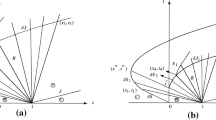Abstract
The well-posedness of the initial-boundary value problems for symmetric hyperbolic systems with strictly dissipative boundary conditions is proved. The regularity assumptions on the coefficients of the differential operator and the boundary condition as well as the boundary itself are quite minimal. Characterizations of strictly dissipative boundary operators are given and the example of Maxwell’s equations is discussed.
Access this chapter
Tax calculation will be finalised at checkout
Purchases are for personal use only
Similar content being viewed by others
References
Benzoni-Gavage, S., Serre, D.: Multidimensional Hyperbolic Partial Differential Equations. Oxford Mathematical Monographs. The Clarendon Press Oxford University Press, Oxford (2007). First-order systems and applications
Cagnol, J., Eller, M.: Boundary regularity for Maxwell’s equations with applications to shape optimization. J. Differ. Eq. 250(2), 1114–1136 (2011)
Chazarain, J., Piriou, A.: Introduction to the theory of linear partial differential equations. In: Studies in Mathematics and its Applications, vol. 14. North-Holland, Amsterdam (1982). Translated from the French
Eller, M.: On symmetric hyperbolic boundary problems with nonhomogeneous conservative boundary conditions. SIAM J. Math. Anal. 4(1), 1925–1949 (2012)
Eller, M.: Loss of derivatives for hyperbolic boundary problems with constant coefficients. Discrete Contin. Dyn. Syst. Ser. B 23(3), 1347–1361 (2018)
Friedrichs, K.O.: Symmetric hyperbolic linear differential equations. Comm. Pure Appl. Math. 7, 345–392 (1954)
Guès, O., Métivier, G., Williams, M., Zumbrun, K.: Uniform stability estimates for constant-coefficient symmetric hyperbolic boundary value problems. Comm. Partial Differ. Eq. 32(4–6), 579–590 (2007)
Kato, T.: Perturbation Theory for Linear Operators, 2nd edn. Springer, Berlin (1976). Grundlehren der Mathematischen Wissenschaften, Band 132
Lax, P.D., Phillips, R.S.: Local boundary conditions for dissipative symmetric linear differential operators. Comm. Pure Appl. Math. 13, 427–455 (1960)
Majda, A., Osher, S.: Initial-boundary value problems for hyperbolic equations with uniformly characteristic boundary. Comm. Pure Appl. Math. 28(5), 607–675 (1975)
Métivier, G.: Stability of multidimensional shocks. In: Advances in the Theory of Shock Waves. Progress in Nonlinear Differential Equations and Their Applications, vol. 47, pp. 25–103. Birkhäuser, Boston (2001)
Métivier, G.: On the L 2 well posedness of hyperbolic initial boundary value problems. Ann. Inst. Fourier (Grenoble) 67(5), 1809–1863 (2017)
Rauch, J.: \(\mathcal {L}_2\) is a continuable initial condition for Kreiss’ mixed problems. Comm. Pure Appl. Math. 25, 265–285 (1972)
Schnaubelt, R., Spitz, M.: Local wellposedness of quasilinear Maxwell equations with absorbing boundary conditions. Evol. Equ. Control Theory (2018). arXiv.org 1812.03803
Acknowledgements
The author wishes to thank J. Naumann (Berlin) for asking the author about the complete proof of Proposition 1.1 in [2] and for reading and commenting on earlier versions of the manuscript. Thanks are also due to the anonymous referee of this paper for a number of helpful comments and suggestions.
Author information
Authors and Affiliations
Corresponding author
Editor information
Editors and Affiliations
Appendix
Appendix
The singular value decomposition of B is B = UTV H where \(V\in L^\infty (\Sigma ,\mathbb {C}^{N\times N})\) and \(U \in L^\infty (\Sigma ,\mathbb {C}^{p\times p})\) are unitary matrices and \(T \in L^\infty (\Sigma , \mathbb {R}^{p\times N})\) is of the form

since B is strictly dissipative. The singular values \(s_1,\ldots ,s_{N_-}\) are uniformly positive a.e. (t, x) ∈ Σ. Define now E = −UT # V H A where

The unitary matrix V = [v 1 … v N] is structured as follows. The first N − columns span N(B)⊥ and the last N − N + − N − columns span N(A). This can be done since N(A) ⊂ N(B). Introduce two N + × N matrices G and F by

and observe that N(G) = N(B)⊥⊕ N(A). One computes

and

since the first N − + N − columns of V are an orthonormal basis of N(A)⊥ = Im A. This proves the first statement.
For the second statement we start by proving N(F)⊥ = AN(B) and N(F) = [AN(B)]⊥. Let y ∈ N(F). Then GAy = 0, that is Ay ∈ N(G) and hence, 〈y, Az〉 = 〈Ay, z〉 = 0 for all z ∈ N(B). This shows N(F) ⊂ [AN(B)]⊥. Now let y ∈ [AN(B)]⊥. Then 0 = 〈y, Az〉 for all z ∈ N(B), which implies Ay ∈ N(G). But this means y ∈ N(F). Note that \(\dim N(F)^\perp = N_+\).
Let z ∈ N(B) ∩ N(F). Then 〈Az, z〉 = 0 and by the strictly dissipativity of B we have 〈Az, z〉≳|Az|2. Hence Az = 0 and we have established N(A) = N(B) ∩ N(F). Let now \(w_1,w_2,..,w_{N_-},v_{N_+ + N_-+1},\ldots ,v_N\) be a basis for N(F). Then \(w_1,w_2,..,w_{N_-},v_{N_-+1},\ldots ,v_N \) is a basis for \(\mathbb {C}^N\) and the square matrix W, whose columns are the vectors of this basis, block-diagonalizes A, that is

By the strict dissipativity of B the matrix A + is uniformly positive definite. Hence, since the matrix A is assumed to have constant signature independent of (t, x) ∈ Σ almost everywhere, we infer that A − must be uniformly negative definite. Thus \(\langle Az,z \rangle \lesssim -|Az|{ }^2\) for all z ∈ N(F).
Finally, observe that F H F = AG H GA where the matrix G H G is the orthogonal projection onto N(B) ⊖ N(A). By the strict dissipativity A is uniformly positive definite on N(B) ⊖ N(A). Thus, the matrix F H F has N + positive eigenvalues bounded away from zero, a.e. (t, x) ∈ Σ.
Rights and permissions
Copyright information
© 2020 Springer Nature Switzerland AG
About this paper
Cite this paper
Eller, M. (2020). On Hyperbolic Initial-Boundary Value Problems with a Strictly Dissipative Boundary Condition. In: Dörfler, W., et al. Mathematics of Wave Phenomena. Trends in Mathematics. Birkhäuser, Cham. https://doi.org/10.1007/978-3-030-47174-3_8
Download citation
DOI: https://doi.org/10.1007/978-3-030-47174-3_8
Published:
Publisher Name: Birkhäuser, Cham
Print ISBN: 978-3-030-47173-6
Online ISBN: 978-3-030-47174-3
eBook Packages: Mathematics and StatisticsMathematics and Statistics (R0)



